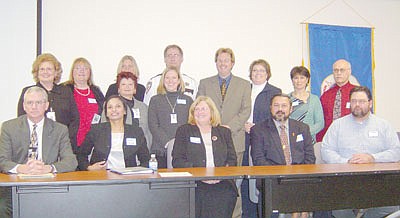December 7, 2006 at 7:10 a.m.
County, Hazelden host federal and state officials’ confab on methamphetamine
Internationally-known Hazelden Center, located not far from the county government center, helped host the program. Hazelden’s research expert Carol Falkowski introduced speakers and offered some of her own observations, along with her colleague from Hazelden Jim Atkins.
Atkins is a recovering methamphetamine addict who suggested to those in the audience that at the very heart of any illegal substance scourge is addiction itself.
There is no easy solution to illegal drug abuse, he continued, because there is no stereotypical user. The only constant is the potential for addiction, which then creates in the user an “inability to do anything but get high.”
Atkins said his life is good now, and has been for a few years, but his life could easily have been wasted if he hadn’t been able to get treatment. He said, “It would have been a tragedy to have spent my life in prison because of meth, I am more than that.”
It’s way too easy to become a “slave” to methamphetamine, he continued. The use of methamphetamine is immediately euphoric, but also quickly devastates the user’s health. He advised that, “Everybody in society should be aware that even though they would never touch the stuff-- “...there will be somebody out there who will offer it to your son or daughter.”
Atkins explained that meth is a “bargain” and is available on the street at about the same price he was buying it 20 years ago.
Keeping people from trying meth (public education) and improving opportunities for treatment are the best approaches.
Chisago County Human Services Director Mary Sheehan echoed that. “Delaying the onset of drug using behavior until later in life” is the best way to reduce addictions, she noted. She asked the federal officials to be a voice for programs offering alternatives for youth offenders and to fund community-based efforts tackling meth.
Chisago County has a Meth Task Force and Drug Court established for non-violent juvenile offenders, and both programs are leading the way in this fight. The county’s public health department and local organizations like Community Partnership in North Branch are also involved. A recovery school for high school age drug-users is operating within the Chisago Lakes School District at a leased site. These are basically all funded with grants.
U.S. Attorney Palouse said her office is “absolutely committed” to helping local agencies find federal funding and resources.
She added that her office cares about meth in Minnesota because it threatens the quality of life in this state. “We see (meth) as a grave threat to that,” Palouse added.
New laws (ie: restricting pseudephedrine access) have helped curtail the lab activity in Minnesota but there’s still meth being imported.
The DEA district agent-in-charge Kent Bailey, said having to buy your colds medicines from behind the counter is “a small price to pay” considering the societal costs of meth production.
O’Malley, Acting Director for the Bureau of Criminal Apprehension, explained that while meth production and arrests continue in Minnesota, the numbers are down from a few years ago.
It was the cooperative response of these and other agencies such as the Dept. of Agriculture and Pollution Control Agency that kept the meth “epidemic” from making an even worse impact in Minnesota.
He added, “It was an almost textbook approach, not blaming others but working together. Ours was a well-reasoned and aggressive response.”
Now that actual lab seizures are lessening O’Malley said law enforcement is putting resources into taking down the traffickers and the organizers of the meth supply chain.
Tenth Judicial Court Judge Robert Rancourt stressed the “sphere of cooperation” that came together to attack this and other substance issues, especially among the young.
Minnesota, he noted, is still third in the nation for meth-related arrests and 52 percent of state offenders are in the criminal justice system because of meth. The average incarceration term for a meth offense in Minnesota is now 71 months. At a cost of about $30,000 annually to incarcerate these people, Rancourt pointed out how costly this issue is to society.
County Probation Officer Bruce Hagstrom mentioned that the Minnesota Association of Probation Officers will be lobbying for a 5 cent per bottle tax to be approved by the legislature. Hagstrom said the probation officers hope to use this funding to pay courts supervision costs and treatment expenses.
****
Meth Awareness Day was established by order of President Bush to give law enforcement officials, local judiciary, health officers and others the impetus to sit down together and hold these talking sessions to see what’s working and what needs to be done all across the U.S.





Comments:
Commenting has been disabled for this item.